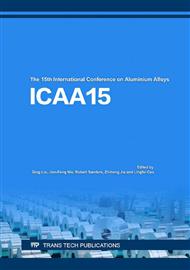p.400
p.409
p.416
p.421
p.427
p.437
p.444
p.450
p.455
Quantification of Fatigue Weaklinks in High Strength Al Alloys
Abstract:
Fatigue weak-link density and strength distribution are materials fatigue properties which are useful in evaluation of alloy quality in terms of the fatigue crack nucleation behavior. This paper reports: 1) an experimental methodology developed to measure fatigue weak-link density and strength distribution by measuring surface crack population as a function of the maximum applied stress, and 2) a quantitative model to quantify fatigue weak-links, based on the 3-D effects of pores in cast alloys. The experimental method could be employed to characterize the fatigue crack initiation behaviors and their anisotropy in wrought and cast Al alloys such as AA8090 Al-Li, AA2026, AA7075 and A713 alloys. It was found that the crack populations were a Weibull function of the applied maximum stress. By fitting this measured curve, fatigue weak-link density could be quantified in these alloys. The derivative of the measured Weibull function resulted in the strength distribution of the fatigue weak-links. The fatigue weak-links could also be quantified from the reconstructed microstructure of a cast Al alloy by analyzing the stress/strain fields around a micro-pore (an elasto-plastic media) under cyclic loading as a function of pore position in depth on surface using a 3-D finite element method. The incubation life for the fatigue crack initiated from a surface pore could be estimated using a microscopic scale Manson-Coffin equation. The results obtained using the 3-D pore-sensitive model were consistent with the experimental results, i.e., the crack population was a Weibull function of the applied stress. The percentage of crack initiation life was found to increase with decrease in cyclic load, i.e., at the stress just above the fatigue limit, it was over 95% the total fatigue life, compared to just 62.5% at the maximum stress of 110% yield strength.
Info:
Periodical:
Pages:
427-434
Citation:
Online since:
November 2016
Price:
Сopyright:
© 2017 Trans Tech Publications Ltd. All Rights Reserved
Share:
Citation:


